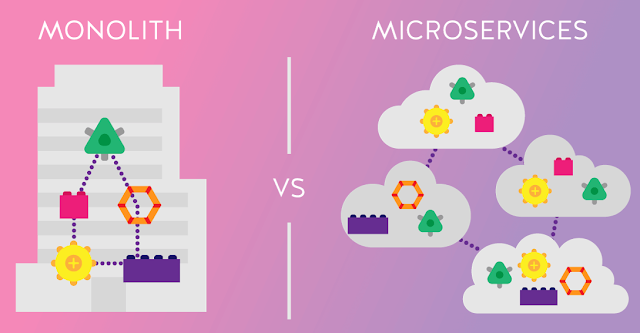Monolithic versus Microservices: A Comprehensive Comparison
In today's rapidly evolving technological landscape, software development approaches are continuously evolving to meet the demands of modern applications.
As businesses strive for agility, scalability, and faster time-to-market, the choice of architecture plays a crucial role in determining the success of a software project. Two prominent architectural styles that have gained significant attention in recent years are monolithic and microservices.
Understanding Monolithic Architecture
Monolithic architecture refers to a traditional software development approach where an application is built as a single, tightly-coupled unit. In this approach, all the components of the application, including the user interface, business logic, and data access layer, are combined into a single codebase. The monolithic approach follows a "one-size-fits-all" philosophy, where all features and functionalities reside within a single application.
Monolithic architecture has been the dominant approach for many years due to its simplicity and ease of development. Developers have a unified codebase and can easily navigate through the application's components. Simplicity often translates into faster development cycles and easier debugging. Additionally, monolithic architectures typically exhibit efficient performance, as there is no network communication overhead between the components. This streamlined communication allows for faster response times and reduced latency.
Moreover, deploying a monolithic application is relatively straightforward. Since all the components are tightly integrated, deploying the entire application involves moving a single codebase to the target environment. This simplicity makes it easier to manage and scale the application as a whole.
Advantages of Monolithic Architecture
- Simplicity and Ease of Development: Monolithic applications are relatively simpler to develop as they involve a single codebase. This simplicity can lead to faster development cycles and easier debugging.
- Efficient Performance: Monolithic architectures often exhibit better performance compared to distributed systems since there is no network communication overhead between components.
- Simplified Deployment: With a monolithic architecture, deploying the entire application becomes a straightforward process. This simplicity makes it easier to manage and scale the application.
Disadvantages of Monolithic Architecture
- Limited Scalability: Monolithic applications can face scalability challenges. Since all components are tightly coupled, scaling individual parts of the system independently becomes difficult.
- Technology Stack Limitations: Monolithic architectures often require the use of a single technology stack, which may limit the flexibility and adaptability of the application to new technologies.
- Higher Risk of Failure: A failure in any part of the monolithic application can bring down the entire system, impacting the availability and reliability of the application.
Understanding Microservices Architecture
Microservices architecture is an alternative approach where applications are built as a collection of small, independent services. Each service focuses on a specific business capability and can be developed, deployed, and scaled independently. Unlike the monolithic approach, where all functionalities reside within a single codebase, microservices advocate breaking down an application into loosely-coupled services that communicate with each other through APIs or lightweight protocols.
The microservices approach offers several advantages that address the limitations of monolithic architecture. One key benefit is scalability and flexibility. With microservices, each service can be scaled independently based on the specific needs of the application. This granularity allows for more efficient resource utilization. For example, if a particular feature experiences increased traffic, only the corresponding microservice needs to be scaled up, while the rest of the application remains unaffected.
Another advantage of microservices architecture is technology diversity. Each microservice can be developed using a different technology stack, chosen based on the specific requirements and strengths of that service. This flexibility enables teams to leverage the most suitable technologies for different business capabilities, promoting innovation and adaptability.
Moreover, microservices architecture enhances fault isolation. Since microservices are decoupled and communicate through lightweight protocols such as HTTP or message queues, failures in one service do not affect the overall system. Each microservice can handle failures independently, ensuring that the application remains resilient and available even when some services experience issues.
Advantages of Microservices Architecture
- Scalability and Flexibility: Microservices offer excellent scalability as each service can be scaled independently based on the specific needs of the application. This flexibility allows for more efficient resource utilization.
- Technology Diversity: Microservices architecture allows developers to use different technology stacks for each service. This enables teams to choose the most suitable technology for specific business requirements.
- Enhanced Fault Isolation: Since microservices are decoupled and communicate via lightweight protocols such as HTTP or message queues, failures in one service do not affect the overall system, increasing fault tolerance.
Disadvantages of Microservices Architecture
Real-World Implementations
- Monolithic Implementation Example: A popular example of a monolithic application is the early version of the e-commerce platform Amazon.com. In the initial stages, Amazon.com was built as a single monolithic application, where all the functionalities, including user management, product catalog, and order processing, were tightly coupled. As the platform grew, Amazon gradually transitioned to a more distributed architecture to overcome scalability challenges.
- Microservices Implementation Example: Netflix is a prime example of a company that successfully adopted microservices architecture. Netflix's streaming platform is composed of various independent services, such as user management, recommendation engine, and content delivery, each operating as a separate microservice. This architecture allows Netflix to scale specific services based on demand and enables frequent updates and improvements without impacting the entire system.
Conclusion
In conclusion, the choice between monolithic and microservices architecture depends on various factors such as scalability requirements, development complexity, and the level of autonomy needed for different components of an application. Monolithic architecture provides simplicity, efficient performance, and ease of deployment. On the other hand, microservices architecture offers scalability, flexibility, technology diversity, and enhanced fault isolation. Ultimately, the decision should be based on careful consideration of the specific needs, goals, and constraints of the application at hand.


Posting Komentar untuk "Monolithic versus Microservices: A Comprehensive Comparison"
Posting Komentar
Silahkan komentar dengan bijak jika ada yang ingin ditanyakan.